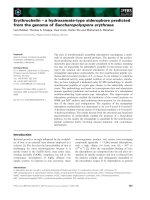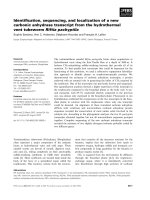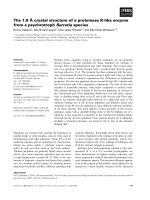A metastatic invasive mole arising from iatrogenic uterus perforation
Bạn đang xem bản rút gọn của tài liệu. Xem và tải ngay bản đầy đủ của tài liệu tại đây (4.29 MB, 4 trang )
Shen et al. BMC Cancer (2017) 17:876
DOI 10.1186/s12885-017-3904-2
CASE REPORT
Open Access
A metastatic invasive mole arising from
iatrogenic uterus perforation
Yuanming Shen1, Xiaoyun Wan1 and Xing Xie1,2*
Abstract
Background: Invasive mole derives from hydatidiform mole, but its pathogenesis remains unknown. Invasive mole
arising from iatrogenic uterine perforation has not been reported yet.
Case presentation: A reproductive woman was admitted because she suffered form severe abdominal pain and
acute intra-abdominal hemorrhage after suction evacuation due to misdiagnosis as inevitable abortion. The patient
underwent hysteroscopy and laparoscopy, by which an iatrogenic uterine perforation and omentum and pelvic
peritoneum metastases were confirmed. All lesions were removed and the final pathological diagnosis was
metastatic invasive mole. The patient underwent post-operative chemotherapy with methotrexate and presented a
good prognosis.
Conclusion: Invasive mole arising form iatrogenic uterine perforation displays an unusual metastatic manner other
than general invasive moles. The prevention of uterine perforation should be emphasized during suction
evacuation for mole pregnancy.
Keywords: Mole pregnancy, Invasive mole, Uterine perforation
Background
Invasive mole is defined as the existence of edematous
and/or degraded villus with trophoblastic proliferation in
the myometrium or extra-uterine metastases which
arises from myometrial invasion of hydatidiform mole
via direct extension through tissue or venous channels.
Previous studies have reported that malignant change
occurs in approximately 15~20% of complete hydatidiform moles (CHMs) and less than 1~5% of partial hydatidiform moles (PHMs) [1–3]. Commonly, invasive mole
is often clinically rather than histologically diagnosed
based on persistent elevated serum human chorionic gonadotropin (hCG) level after the evacuation of mole
tissues. The etiologic events contributing to the development of invasive mole are unclear except for some highrisk factors, such as regional differences or racial
variations, older or younger maternal age, a lack of vitamin A in diet, and others [3, 4]. Invasive mole arising
from iatrogenic event has not been reported yet.
* Correspondence:
1
Department of Gynecologic Oncology, Women’s Hospital, School of
Medicine, Zhejiang University, Hangzhou 310006, China
2
Women’s Reproductive Health Laboratory of Zhejiang Province, Women’s
Hospital, School of Medicine, Zhejiang University, Hangzhou, China
Invasive mole generally limits in uterine myometrial
invasion and extra-uterine metastases occur in only 5%
of CHMs and rare cases in PHMs [3, 4]. Metastases are
developed mainly through hematogenous spread and
lung (80%) is the most common metastatic site, followed
by vagina (30%), pelvis (20%), liver (10%), brain (10%),
and others (<5%) [3–5]. Metastasis to the pelvic peritoneum or omentum, independent of uterine myometrial
invasion and lung metastases, is extremely rare in invasive mole. Here, we reported a case of invasive mole that
derived from iatrogenic uterine perforation and showed
a special metastatic manner. This case awakes us that
the prevention of uterine perforation should be emphasized during suction evacuation for mole pregnancy.
Case presentation
A 34-year-old woman, G5P2A2, referred to our hospital
(Women’s Hospital, School of Medicine, Zhejiang
University, Hangzhou, China) because of irregular vaginal bleeding and elevated serum hCG level. She had
undergone suction curettage one month ago due to initial diagnosis of inevitable abortion at approximately
8 weeks of gestation in a local hospital. Thenceforth, she
suffered persistent vaginal bleeding with rebound serum
© The Author(s). 2017 Open Access This article is distributed under the terms of the Creative Commons Attribution 4.0
International License ( which permits unrestricted use, distribution, and
reproduction in any medium, provided you give appropriate credit to the original author(s) and the source, provide a link to
the Creative Commons license, and indicate if changes were made. The Creative Commons Public Domain Dedication waiver
( applies to the data made available in this article, unless otherwise stated.
Shen et al. BMC Cancer (2017) 17:876
hCG levels for 3 weeks. Weekly serum hCG levels were
5310 IU/L, 7600 IU/L, and 9121 IU/L after the second
curettage, while the levels of other tumor markers were
within the normal ranges. An ultrasound examination
revealed normal ultrasonic echo in both uterine myometrium and parenchyma except for irregular echo of uterine endometrium and a little enlarged uterus (Fig. 1a).
After admission to our hospital, a pathological diagnosis
of CHM was confirmed according to the HE slices from
first curettage. All the imaging data which were performed in local hospital were reanalyzed and reconfirmed. Additional abdomen and pelvis CT scan were
done in our hospital. All the imaging scans were normal.
Combining the symptoms, previous history of CHM,
and elevated hCG level, the initial diagnosis was considered as gestational trophoblastic neoplasia (GTN). The
patient suddenly presented severe abdominal pain in the
second early morning after hospitalization and the
ultrasound examination showed intra-abdominal
hemorrhage.
Combined emergency hysteroscopy and laparoscopy
were performed. Hysteroscopy revealed an empty uterine cavity without gestational tissue except for an old
Page 2 of 4
iatrogenic uterine perforation at right fundus of uterine.
Under laparoscopy, an iatrogenic uterine perforation was
confirmed. Totally 300 ml uncoagulated blood were collected in pelvic cavity and three mole lesions with darkbrownish, coin-sized bleeding spot were noted, one was
at the pelvic peritoneum near the right uterosacral ligament (about 2 × 2 cm), another was at posterior uterine
serosa (0.3 × 0.3 cm), and the third was on the omentum
(3 × 2 cm) (Fig. 1c–e). Both sides of adnexae appeared
normal. The iatrogenic uterine perforation was mended.
All lesions of mole were removed. The abdomen and
pelvis CT and MRI images were postoperatively rereviewed, and a mass (3.03 × 1.56CM) on omentum was
found in CT scan, as shown in Fig. 1b. The final pathological diagnosis of the three mole lesions was invasive
mole. As showed in Fig. 1f and g, edematous villus with
trophoblastic cells significantly invaded into the pelvic
peritoneum and omentum metastatic sites. Thus, the
patient was diagnosed as FIGO stage IV with score of 3
(1 for hCG level > 1000 U/L, 1 for >3 cm metastasis on
omentum, and 1 for three identified metastases lesions).
According to 2000 FIGO staging, a risk score of 6 and
below is classified as low risk. Thus, the patient
Fig. 1 a-b An ultrasound examination (a) and a CT scan (b) of the uterine and pelvis. c-e An iatrogenic uterine perforation (arrow) (c) and the
lesions [right uterosacral ligament (d) and omentum (e)] of mole under laparoscopy. f-g Edematous villus with trophoblastic proliferation was
significant in omentum (f) and right uterosacral ligament (g)
Shen et al. BMC Cancer (2017) 17:876
underwent chemotherapy with single methotrexate regimen (4 mg/kg at day 1–5, 2-week interval). The serum
hCG level was rapidly decreased. At the end of the second course of methotrexate chemotherapy, the hCG
level dropped to negative, and additional 2 courses of
chemotherapy was given. The woman was followed up
to one year and her hCG level was normal.
Discussion and conclusions
Suction evacuation as the standard therapeutic strategy
should be done as soon as possible after the diagnosis of
hydatidiform mole [6]. Uterine perforation is a potential
complication of uterine suction and surgical curettage,
easily occurring in mole pregnancy because of a big and
soft uterus [6]. The perforation may lead to the damage
of intraperitoneal organs, even heavy intraperitoneal
hemorrhage. This was a first reported case of invasive
mole that resulted from iatrogenic uterine perforation,
to the best of our knowledge. This patient was misdiagnosed as inevitable abortion before curettage. Imaginably, a sharp curettage was performed blindly which
might lead to uterus perforation consequently. A proper
surgical technique in evacuation of molar pregnancies is
very important, including a sufficient preoperative evaluation to exclude hyperthyroidism, hypertension, severe
anemia, and others; suitable dilation of cervical os
according to gestational weeks; gently operation for dilation, suction, and curettage to avoid uterine perforation.
Oxytocin infusion is recommended after cervix dilation
during suction curettage. In general, the operation
should be performed by an experienced gynecologist
under ultrasound guidance.
Invasive moles have the same histopathological characteristics as that of a non-invasive hydatidiform mole
except for the infiltration of the trophoblasts into the
myometrium and the necrotic changes associated with
it. Up to date, the pathogenesis of invasive mole still remains unknown. The dysfunction of oncogenes and
anti-oncogenes might contribute to the malignant transformation of the trophoblasts in invasive mole, like in
other malignancies [7]. For this case, we hypothesized
that the trophoblasts might have had inherent genes dysfunction and uterine perforation only offered a metastatic path. Generally invasive mole causes invasion of
villous fragments into the uterine myometrium, minority
causes metastasis in distant organs (mostly to lung) via
hematogenous metastasis [5]. Primary intra-abdominal
involvement without uterine myometrial invasion and
lung metastasis is extremely rare. However, this special
case arising form iatrogenic uterus perforation represented an unusual metastatic manner other than general
invasive mole. Metastases to peritoneum and omentum
occurred independently of uterine myometrial invasion
and lung metastases. We presumed that the trophoblasts
Page 3 of 4
might directly via the perforation site rather than venous
channels, leading to peritoneum and omentum implantation. According to FIGO staging, this patient belonged
to an advantage disease. It is unclear whether the prognoses are different between this patient and those with
same stage through general metastatic manners. In our
report, woman underwent four courses of single methotrexate chemotherapy after operation, the prognosis was
good.
In summary, we reported a special case of invasive
mole arising from iatrogenic uterine perforation, which
showed an unusual metastatic manner other than general invasive mole. This avoidable case suggests that the
prevention of uterine perforation should be emphasized
during suction evacuation for mole pregnancy.
Teaching points
1. A proper surgical technique in evacuation of molar
pregnancy should be emphasized.
2. Invasive mole arising form iatrogenic uterine
perforation displays an unusual metastatic manner.
Abbreviations
CHMs: Complete hydatidiform moles; GTN: Gestational trophoblastic
neoplasia; HCG: Human chorionic gonadotropin; MRI: Magnetic resonance
imaging; PHMs: Partial hydatidiform moles
Acknowledgements
Not applicable.
Funding
National Natural Science Foundation of China NO. 81501233; Health &
Medicine of Zhejiang province China NO. 2016KYB164.
Availability of data and materials
The data-sets used and/or analyzed during the current study are available
from the corresponding author on reasonable request.
Authors’ contributions
SYM reviewed the literature, prepared the data and also drafted and revised
the manuscript. WXY cared the patient and participated in the design and
coordination of the study. XX participated in the design of the study and
revised the manuscript. All authors read and approved the final manuscript.
Ethics approval and consent to participate
This research conformed to the provisions of the Declaration of Helsinki. The
patient was informed and provided her written informed consent. This study was
approved by the ethics committee of Women’s hospital Zhejiang University.
Consent for publication
Written informed consent was obtained from the patient for publication of
this Case report and any accompanying images. A copy of the written consent
is available for review by the Editor of this journal.
Competing interests
The authors declare that they have no competing interests.
Publisher’s Note
Springer Nature remains neutral with regard to jurisdictional claims in
published maps and institutional affiliations.
Shen et al. BMC Cancer (2017) 17:876
Page 4 of 4
Received: 9 October 2017 Accepted: 8 December 2017
References
1. El-Helw LM, Hancock BW. Treatment of metastatic gestational trophoblastic
neoplasia. Lancet Oncol. 2007;8(8):715–24. Review
2. Shih IM. Gestational trophoblastic neoplasia—pathogenesis and potential
therapeutic targets. Lancet Oncol. 2007;8(7):642–50.
3. Seckl MJ, Sebire NJ, Berkowitz RS. Gestational trophoblastic disease. Lancet.
2010;376:717–29.
4. Brown J, Naumann RW, Seckl MJ, Schink J. 15years of progress in
gestational trophoblastic disease: scoring, standardization, and salvage.
Gynecol Oncol. 2017;144(1):200–7.
5. Seckl MJ, Sebire NJ, Fisher RA, Golfier F, Massuger L, Sessa C, ESMO
Guidelines Working Group. Gestational trophoblastic disease: ESMO Clinical
Practice Guidelines for diagnosis, treatment and follow-up. Ann Oncol. 2013;
24(Suppl 6):vi39–50.
6. Candelier JJ. The hydatidiform mole. Cell Adhes Migr. 2016;10(1–2):226–35.
7. Alifrangis C, Seckl MJ. Genetics of gestational trophoblastic neoplasia: an
update for the clinician. Future Oncol. 2010;6(12):1915–23.
Submit your next manuscript to BioMed Central
and we will help you at every step:
• We accept pre-submission inquiries
• Our selector tool helps you to find the most relevant journal
• We provide round the clock customer support
• Convenient online submission
• Thorough peer review
• Inclusion in PubMed and all major indexing services
• Maximum visibility for your research
Submit your manuscript at
www.biomedcentral.com/submit









